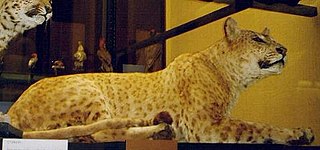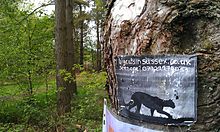Phantom cats, also known as alien big cats (ABCs), are large felids which allegedly appear in regions outside their indigenous range. Sightings, tracks, and predation have been reported in a number of countries including Australia, Canada, China, Denmark, Finland, France, Germany, Great Britain, Ireland, India, Italy, Luxembourg, Netherlands, New Zealand, Spain, Switzerland, and the United States. When confirmed, they are typically explained as exotic pets or escapees from private zoos.

The cougar, also known as the puma, mountain lion, catamount, or panther, is a large cat native to the Americas, second in size only to the stockier jaguar. They are not technically grouped with the "true" big cats, as they are slightly smaller than other big cats, and they lack the vocal physiology to roar. Its range spans the Canadian Provinces of the Yukon, British Columbia, and Alberta, the Rocky Mountains, and other areas in the Western United States. Their range extends further south through Mexico, where they are found in nearly every state, to the Amazon Rainforest and the southern Andes Mountains in Patagonia. The puma inhabits every mainland country in Central and South America, making it the most widely distributed large, wild, terrestrial mammal in the Western Hemisphere, and one of the most widespread on planet Earth. It is an adaptable, generalist species, occurring in most American habitat types. It prefers habitats with dense underbrush and rocky areas for stalking but also lives in open areas.
The term "big cat" is typically used to refer to any of the five living members of the genus Panthera, namely the tiger, lion, jaguar, leopard, and snow leopard, as well as the non-pantherine cheetah and cougar.

Exmoor is loosely defined as an area of hilly open moorland in west Somerset and north Devon in South West England. It is named after the River Exe, the source of which is situated in the centre of the area, two miles north-west of Simonsbath. Exmoor is more precisely defined as the area of the former ancient royal hunting forest, also called Exmoor, which was officially surveyed 1815–1818 as 18,810 acres (7,610 ha) in extent. The moor has given its name to a National Park, which includes the Brendon Hills, the East Lyn Valley, the Vale of Porlock and 55 km (34 mi) of the Bristol Channel coast. The total area of the Exmoor National Park is 692.8 km2 (267.5 sq mi), of which 71% is in Somerset and 29% in Devon.

A Congolese spotted lion, also known by the portmanteau lijagulep, is the hybrid of a male lion and female jaguar-leopard. Several lijaguleps have been bred, but only one appears to have been exhibited as a Congolese spotted lion. It was most likely given that name by a showman because the public were more interested in exotic captured animals than in captive-bred hybrids.

A werecat is an analog to "werewolf" for a feline therianthropic creature.

A felid hybrid is any of a number of hybrids between various species of the cat family, Felidae. This article deals with hybrids between the species of the subfamily Felinae.

The North American cougar is a cougar subspecies in North America. It is the biggest cat in North America. It was once common in eastern North America and is still prevalent in the western half of the continent. This subspecies includes populations in western Canada, the western United States, Florida, Mexico and Central America, and possibly South America northwest of the Andes Mountains. It thus includes the extirpated eastern cougar and extant Florida panther populations.

The Highland Wildlife Park is a 105-hectare (260-acre) safari park and zoo near Kingussie, Highland, Scotland. The park is located within the Cairngorms National Park. The park is run by the Royal Zoological Society of Scotland and is a member of the British and Irish Association of Zoos and Aquariums (BIAZA) and the European Association of Zoos and Aquaria (EAZA).

Exmoor Zoo is a conservation centre in Exmoor, North Devon, England. The zoo developed from Exmoor Bird Gardens, opened on the site of a farm in 1982. The current owners took over in 1993, and have enlarged and developed the zoo, now specialising in the conservation of smaller animals. The zoo has been a member of BIAZA, the British and Irish Association of Zoos and Aquariums, since 1995 and recently became a member of EAZA in 2018.

The Zanzibar leopard is an African leopard population on Unguja Island in the Zanzibar archipelago, Tanzania, that is considered extirpated due to persecution by local hunters and loss of habitat. It was the island's largest terrestrial carnivore and apex predator. Increasing conflict between people and leopards in the 20th century led to the demonization of the Zanzibar leopard and determined attempts to exterminate it. Efforts to develop a leopard conservation program in the mid-1990s were shelved when wildlife researchers concluded that there was little prospect for the population's long-term survival. In 2018, a leopard was recorded by a camera trap, thus renewing hopes for the population's survival, although some experts remain skeptical.
Mary Rose Cawley was a 1970s British circus entertainer who specialised in a chimpanzee act. She was also known as an animal trainer, providing numerous animals for various BBC productions and the 1967 movie Doctor Dolittle. She was later convicted on several counts of animal cruelty.
Afghanistan has long been known for diverse wildlife. Many of the larger mammals in the country are categorized by the International Union for Conservation of Nature (IUCN) as globally threatened. These include the snow leopard, Marco Polo sheep, Siberian musk deer, markhor, urial, and the Asiatic black bear. Other species of interest are the ibex, the gray wolf, and the brown bear, striped hyenas, and numerous bird of prey species. Most of the Marco Polo sheep and ibex are being poached for food, whereas wolves, snow leopards and bears are being killed for damage prevention.

The eastern cougar or eastern puma is a subspecies designation proposed in 1946 for cougar populations in eastern North America. The subspecies as described in 1946 was declared extinct by the U.S. Fish and Wildlife Service in 2011. However, the 1946 taxonomy is now in question. The Canadian Wildlife Service has taken no position on the taxonomy. Cougars are currently common in western North America and may be expanding their range. Individuals are occasionally seen as vagrants in eastern North America.

Borth Wild Animal Kingdom, formerly known as Borth Animalarium, is a zoo, located in the seaside Welsh town of Borth, 7 miles north of Aberystwyth in the county of Ceredigion, Mid Wales. It occupies 12 acres and in 2015 had some 27,000 visitors..

The Beast of Bladenboro refers to a creature responsible for a string of deaths amongst Bladenboro, North Carolina animals in the winter of 1953–54. According to witnesses and trackers, it was likely a wildcat species, but its identity was ultimately not definitively confirmed. According to reports, the animal commonly crushed or decapitated its victims, which were mostly dogs.
A pet exotic felid, also called pet wild cat or pet non-domestic cat, is a member of the family Felidae kept as an exotic pet.
Reece Oliver is a British animal conservationist, zookeeper, and former show jumper. He is the founder and operator of the Strelley Wildlife Conservation Facility, based in Nottingham, which provides a home for rescued animals, including lions, squirrel monkeys, wallabies, puma and various other wildlife species.















